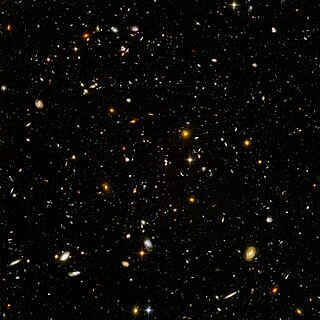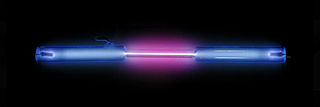
A neutrino is a fermion that interacts only via the weak interaction and gravity. The neutrino is so named because it is electrically neutral and because its rest mass is so small (-ino) that it was long thought to be zero. The rest mass of the neutrino is much smaller than that of the other known elementary particles. The weak force has a very short range, the gravitational interaction is extremely weak due to the very small mass of the neutrino, and neutrinos do not participate in the electromagnetic interaction or the strong interaction. Thus, neutrinos typically pass through normal matter unimpeded and undetected.

Particle physics or high-energy physics is the study of fundamental particles and forces that constitute matter and radiation. The field also studies combinations of elementary particles up to the scale of protons and neutrons, while the study of combination of protons and neutrons is called nuclear physics.

The universe is all of space and time and their contents. It comprises all of existence, any fundamental interaction, physical process and physical constant, and therefore all forms of energy and matter, and the structures they form, from sub-atomic particles to entire galaxies. Space and time, according to the prevailing cosmological theory of the Big Bang, emerged together 13.787±0.020 billion years ago, and the universe has been expanding ever since. Today the universe has expanded into an age and size that is physically only in parts observable as the observable universe, which is approximately 93 billion light-years in diameter at the present day, while the spatial size, if any, of the entire universe is unknown.
In physical cosmology, leptogenesis is the generic term for hypothetical physical processes that produced an asymmetry between leptons and antileptons in the very early universe, resulting in the present-day dominance of leptons over antileptons. In the currently accepted Standard Model, lepton number is nearly conserved at temperatures below the TeV scale, but tunneling processes can change this number; at higher temperature it may change through interactions with sphalerons, particle-like entities. In both cases, the process involved is related to the weak nuclear force, and is an example of chiral anomaly.
Quark matter or QCD matter refers to any of a number of hypothetical phases of matter whose degrees of freedom include quarks and gluons, of which the prominent example is quark-gluon plasma. Several series of conferences in 2019, 2020, and 2021 were devoted to this topic.

In physical cosmology, the baryon asymmetry problem, also known as the matter asymmetry problem or the matter–antimatter asymmetry problem, is the observed imbalance in baryonic matter and antibaryonic matter in the observable universe. Neither the standard model of particle physics nor the theory of general relativity provides a known explanation for why this should be so, and it is a natural assumption that the universe is neutral with all conserved charges. The Big Bang should have produced equal amounts of matter and antimatter. Since this does not seem to have been the case, it is likely some physical laws must have acted differently or did not exist for matter and antimatter. Several competing hypotheses exist to explain the imbalance of matter and antimatter that resulted in baryogenesis. However, there is as of yet no consensus theory to explain the phenomenon, which has been described as "one of the great mysteries in physics".
Even restricting the discussion to physics, scientists do not have a unique definition of what matter is. In the currently known particle physics, summarised by the standard model of elementary particles and interactions, it is possible to distinguish in an absolute sense particles of matter and particles of antimatter. This is particularly easy for those particles that carry electric charge, such as electrons, protons or quarks, while the distinction is more subtle in the case of neutrinos, fundamental elementary particles that do not carry electric charge. In the standard model, it is not possible to create a net amount of matter particles—or more precisely, it is not possible to change the net number of leptons or of quarks in any perturbative reaction among particles. This remark is consistent with all existing observations.
The cosmic neutrino background is the universe's background particle radiation composed of neutrinos. They are sometimes known as relic neutrinos.
In physical cosmology, the hadron epoch started 20 microseconds after the Big Bang. The temperature of the universe had fallen sufficiently to allow the quarks from the preceding quark epoch to bind together into hadrons. Initially, the temperature was high enough to allow the formation of hadron/anti-hadron pairs, which kept matter and anti-matter in thermal equilibrium. Following the annihilation of matter and antimatter, a nano-asymmetry of matter remains to the present day. Most of the hadrons and anti-hadrons were eliminated in annihilation reactions, leaving a small residue of hadrons. Upon elimination of anti-hadrons, the Universe was dominated by photons, neutrinos and electron-positron pairs. One refers to this period as the lepton epoch.
In physical cosmology, the electroweak epoch was the period in the evolution of the early universe when the temperature of the universe had fallen enough that the strong force separated from the electroweak interaction, but was high enough for electromagnetism and the weak interaction to remain merged into a single electroweak interaction above the critical temperature for electroweak symmetry breaking. Some cosmologists place the electroweak epoch at the start of the inflationary epoch, approximately 10−36 seconds after the Big Bang. Others place it at approximately 10−32 seconds after the Big Bang when the potential energy of the inflaton field that had driven the inflation of the universe during the inflationary epoch was released, filling the universe with a dense, hot quark–gluon plasma. Particle interactions in this phase were energetic enough to create large numbers of exotic particles, including W and Z bosons and Higgs bosons. As the universe expanded and cooled, interactions became less energetic and when the universe was about 10−12 seconds old, W and Z bosons ceased to be created at observable rates. The remaining W and Z bosons decayed quickly, and the weak interaction became a short-range force in the following quark epoch.
In physical cosmology, the photon epoch was the period in the evolution of the early universe in which photons dominated the energy of the universe. The photon epoch started after most leptons and anti-leptons were annihilated at the end of the lepton epoch, about 10 seconds after the Big Bang. Atomic nuclei were created in the process of nucleosynthesis, which occurred during the first few minutes of the photon epoch. For the remainder of the photon epoch, the universe contained a hot dense plasma of nuclei, electrons and photons.
The timeline of particle physics lists the sequence of particle physics theories and discoveries in chronological order. The most modern developments follow the scientific development of the discipline of particle physics.
In physical cosmology, the quark epoch was the period in the evolution of the early universe when the fundamental interactions of gravitation, electromagnetism, the strong interaction and the weak interaction had taken their present forms, but the temperature of the universe was still too high to allow quarks to bind together to form hadrons. The quark epoch began approximately 10−12 seconds after the Big Bang, when the preceding electroweak epoch ended as the electroweak interaction separated into the weak interaction and electromagnetism. During the quark epoch, the universe was filled with a dense, hot quark–gluon plasma, containing quarks, leptons and their antiparticles. Collisions between particles were too energetic to allow quarks to combine into mesons or baryons. The quark epoch ended when the universe was about 10−6 seconds old, when the average energy of particle interactions had fallen below the binding energy of hadrons. The following period, when quarks became confined within hadrons, is known as the hadron epoch.
Current observations suggest that the expansion of the universe will continue forever. The prevailing theory is that the universe will cool as it expands, eventually becoming too cold to sustain life. For this reason, this future scenario once popularly called "Heat Death" is now known as the "Big Chill" or "Big Freeze".
The chronology of the universe describes the history and future of the universe according to Big Bang cosmology.

In classical physics and general chemistry, matter is any substance that has mass and takes up space by having volume. All everyday objects that can be touched are ultimately composed of atoms, which are made up of interacting subatomic particles, and in everyday as well as scientific usage, matter generally includes atoms and anything made up of them, and any particles that act as if they have both rest mass and volume. However it does not include massless particles such as photons, or other energy phenomena or waves such as light or heat. Matter exists in various states. These include classical everyday phases such as solid, liquid, and gas – for example water exists as ice, liquid water, and gaseous steam – but other states are possible, including plasma, Bose–Einstein condensates, fermionic condensates, and quark–gluon plasma.
In Big Bang cosmology, neutrino decoupling was the epoch at which neutrinos ceased interacting with other types of matter, and thereby ceased influencing the dynamics of the universe at early times. Prior to decoupling, neutrinos were in thermal equilibrium with protons, neutrons and electrons, which was maintained through the weak interaction. Decoupling occurred approximately at the time when the rate of those weak interactions was slower than the rate of expansion of the universe. Alternatively, it was the time when the time scale for weak interactions became greater than the age of the universe at that time. Neutrino decoupling took place approximately one second after the Big Bang, when the temperature of the universe was approximately 10 billion kelvin, or 1 MeV.
In cosmology, recombination refers to the epoch during which charged electrons and protons first became bound to form electrically neutral hydrogen atoms. Recombination occurred about 378,000 years after the Big Bang. The word "recombination" is misleading, since the Big Bang theory doesn't posit that protons and electrons had been combined before, but the name exists for historical reasons since it was named before the Big Bang hypothesis became the primary theory of the birth of the universe.
In cosmology, decoupling is a period in the development of the universe when different types of particles fall out of thermal equilibrium with each other. This occurs as a result of the expansion of the universe, as their interaction rates decrease up to this critical point. The two verified instances of decoupling since the Big Bang which are most often discussed are photon decoupling and neutrino decoupling, as these led to the cosmic microwave background and cosmic neutrino background, respectively.

The Future Circular Collider (FCC) is a proposed particle accelerator with an energy significantly above that of previous circular colliders, such as the Super Proton Synchrotron, the Tevatron, and the Large Hadron Collider (LHC). The FCC project is considering three scenarios for collision types: FCC-hh, for hadron-hadron collisions, including proton-proton and heavy ion collisions, FCC-ee, for electron-positron collisions, and FCC-eh, for electron-hadron collisions.





